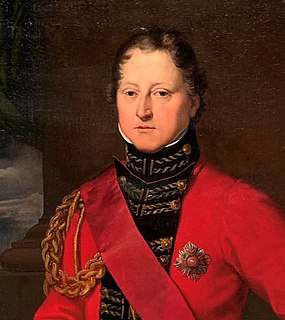Related Research Articles

The Province of Upper Canada was a part of British Canada established in 1791 by the Kingdom of Great Britain, to govern the central third of the lands in British North America, formerly part of the Province of Quebec since 1763. Upper Canada included all of modern-day Southern Ontario and all those areas of Northern Ontario in the Pays d'en Haut which had formed part of New France, essentially the watersheds of the Ottawa River or Lakes Huron and Superior, excluding any lands within the watershed of Hudson Bay. The "upper" prefix in the name reflects its geographic position along the Great Lakes, mostly above the headwaters of the Saint Lawrence River, contrasted with Lower Canada to the northeast.

William Lyon Mackenzie also spelt McKenzie and MacKenzie, was a Scottish-born Canadian-American journalist and politician. His strong views on political equality and clean government drove him to outright rebellion in 1837 after a career as mayor of Toronto and in the colonial legislative assembly of Upper Canada (Ontario). He led the 1837 Upper Canada Rebellion and during its bitter end he set up a small rebel enclave named "Republic of Canada," where he served as president December 13, 1837 to January 14, 1838. After a period of exile in the U.S., he returned to Canada and served as an elected member of the Legislative Assembly of the Province of Canada from 1851 to 1858.

Fort Erie is a town on the Niagara River in the Niagara Region, Ontario, Canada. It is directly across the river from Buffalo, New York and is the site of Old Fort Erie which played a prominent role in the War of 1812.

The Regional Municipality of Niagara, also colloquially known as the Niagara Region, is a regional municipality comprising twelve municipalities of Southern Ontario, Canada. The regional seat is in Thorold. It is the southern end of the Golden Horseshoe, the largest megalopolis in Canada.

General Sir Gordon Drummond, GCB was a Canadian-born British Army officer and the first official to command the military and the civil government of Canada. As Lieutenant Governor of Upper Canada, Drummond distinguished himself on the Niagara front in the War of 1812 and later became Governor-General and Administrator of Canada.

Peter Buell Porter was an American lawyer, soldier and politician who served as United States Secretary of War from 1828 to 1829.
Ridgeway is a small, unincorporated village in Fort Erie, Ontario, Canada. The community is within the Niagara Regional Municipality. It used to be the seat of government for Bertie Township within Welland County. Ridgeway is now a part of the Town of Fort Erie. In recent years the rail line has been converted to a walking and cycling trail, part of a trail system circling the Niagara region.

Welland County is a historic county in the Canadian province of Ontario.

Niagara Falls is a federal electoral district in Ontario, Canada, that has been represented in the House of Commons of Canada since 1953.

Niagara Centre is a federal electoral district in the Niagara Region of Ontario that has been represented in the House of Commons of Canada from 1867 to 1988 and since 1997.

The Legislative Assembly of Upper Canada was the elected part of the legislature for the province of Upper Canada, functioning as the lower house in the Parliament of Upper Canada. Its legislative power was subject to veto by the appointed Lieutenant Governor, Executive Council, and Legislative Council.
The 11th Parliament of Upper Canada was opened on 7 January 1831. Elections in Upper Canada had been held in October 1830, and all sessions were held at York, then later at Toronto. This parliament was dissolved on 1 September 1834.
Robert Hamilton was a businessman, judge and political figure in Upper Canada.

The Welland Canal has gone through many incarnations in its history. Today, five distinct canal-construction efforts are recognized. The retronym First Welland Canal is applied to the original canal, constructed from 1824 to 1829 and 1831 to 1833.
Thomas Dickson was a businessman and political figure in Upper Canada.

John Charles Rykert was a lawyer and Conservative member of the House of Commons of Canada. He represented Lincoln from 1878 to 1882 and Lincoln and Niagara from 1882 to 1891. He represented Lincoln in the Legislative Assembly of Ontario from 1867 to 1878.

Gilbert McMicken was a Canadian businessman and political figure. He served on the Council of Keewatin the governing body of the District of Keewatin from 1876 to 1877.
Benjamin Hardison was a farmer, miller and political figure in Upper Canada. He represented 4th Lincoln and Norfolk in the Legislative Assembly of Upper Canada from 1797 to 1800.
John Warren was a soldier, official and merchant in Upper Canada.

The 55th New York State Legislature, consisting of the New York State Senate and the New York State Assembly, met from January 3 to July 2, 1832, during the fourth year of Enos T. Throop's governorship, in Albany.
References
- ↑ Tolan, Eva Elliott (December 12, 1959). "Reminders of the Past, Bertie's Early Settlers". Niagara Falls Review . Retrieved 2010-12-15.